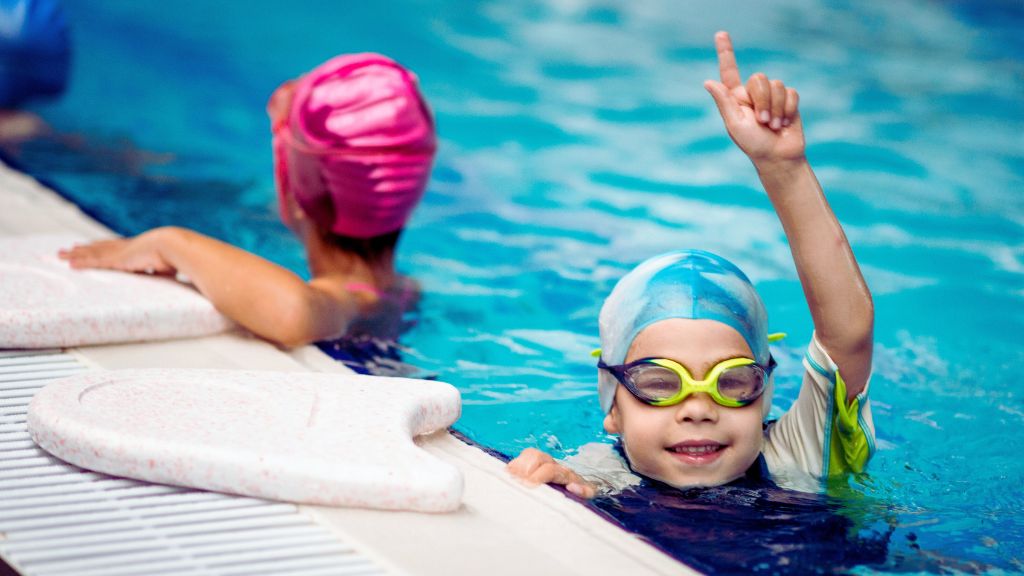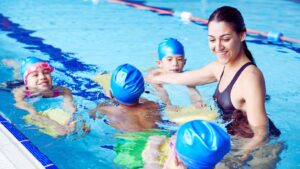Table of Contents
How Can I Keep My Child with Autism Safe While Swimming?
Water safety is a top concern for many caregivers of children and teenagers with an autism spectrum disorder (ASD) diagnosis, especially around swimming season when more pool party invites and swim lesson flyers arrive. While engaging in the water can be tremendously beneficial for many on the ASD spectrum, it can also be unsafe if water safety practices are not an aspect of the experience.
In fact, according to the National Autism Society, children with autism are roughly 160 times more likely to die from drowning than children in the general public. Features related to autism that some individuals experience can, at times, make the ASD population more prone to threats around water than others. Sadly, unintentional drownings in ASD can even be fatal at times.
Due to these concerning statistics and more, many neurodiverse families find themselves asking questions like, how can I keep my child with autism safe while swimming?
Fortunately, taking proactive water safety measures, such as providing ABA support and understanding the challenges of autism that may pose risks around water, helps many families enjoy safer experiences throughout the year.
This blog by ABA Centers of Pennsylvania aims to provide helpful ABA tips to prevent drowning incidents among the ASD population and ensure their safety while swimming or engaging with water. We will also discuss in further detail why water safety can be difficult for some individuals with autism and how families can mitigate these challenges.
So please keep reading about essential water safety skills so your child with ASD can play in the water with less worry, and everyone can have way more fun!
Click here to learn more information about ABA Centers of Pennsylvania. Visit us here to read more blogs about autism, ABA, and neurodiversity.
Understanding Autism Spectrum Disorder
Before diving into specific strategies for water safety for youth with autism, it is vital to understand some key ASD characteristics that can make those with autism more vulnerable around the water.
Those with ASD may exhibit a range of symptoms and behaviors, but some common traits include:
- Difficulty with social interactions and communication
- Repetitive or restrictive behaviors and interests
- Sensory processing difficulties
- Need for routine and predictability
These are characteristics caregivers and providers should always consider when setting water safety expectations and implementing ABA strategies for swimming with autism.
Autism Spectrum Disorder and Drowning Risks
The following are a few common risk factors in the context of water safety that can lead to the unintentional drowning of those with autism, like the passing of a child in Massachusetts who was recently found unresponsive in a neighbor’s pool.
Fortunately, by learning more about water safety in the context of autism, you limit the potential for dangerous outcomes for those on the spectrum. You also help ensure safer engagement at the poolside, near the beach, or in any body of water.
1. Attraction to Water
Many children with autism are attracted to bodies of water, such as beaches, pools, lakes, or even bathtubs. Their fascination with water can put them at risk for unintentional drowning incidents, which increases if elopement is also a behavior they struggle with.
2. Challenges Conceptualizing Water Safety
Those with autism may have difficulty understanding safety rules and regulations around water. They may not fully comprehend the concept of water depth or recognize that they cannot breathe underwater.
3. Sensory Processing Difficulties
Some with autism may have sensory processing difficulties that can make it hard for them to detect danger. For example, they may not feel cold temperatures in the same way as others do, which could lead to hypothermia if they stay in the water for too long.
4. Lack of Safety Measures
Parents and caregivers should always take appropriate measures to ensure safety for those with autism. However, at times, periods of poor supervision can lead those with ASD into dangerous situations around water.
How ABA Can Help with Water Safety
ABA therapy is an evidence-based, structured approach to managing behavior and developmental challenges in those with autism. ABA techniques teach essential safety skills that can be helpful for staying safe around water, including but never limited to:
- Listening to instructions
- Following rules
- Recognizing danger signs
Through discrete trial teaching (DTT) and natural environment teaching (NET), just a few fundamental ABA approaches, ABA providers can help children develop critical skills for staying safe around water.
Moreover, ABA providers can also help address sensory issues that may influence a child’s ability to understand and respond appropriately in water-related situations. ABA therapy also addresses underlying communication or social skills deficits that may impact an ASD child’s ability to learn and follow safety rules related to water.
In addition to teaching these specific skillsets, ABA therapy can also promote overall behavioral regulation and self-control in ASD, which can be especially helpful in water and drowning emergencies but also throughout life.
Water Safety for Kids on the Spectrum: 8 Essential ABA Tips
Here are eight essential ABA tips to support parents in teaching water safety skills to their children with autism:
1. Use Positive Reinforcement
Positive reinforcement can motivate water safety behaviors so they occur more often. Use various forms of highly reinforcing praise and rewards to encourage your child to follow safety rules consistently so they become second nature.
2. Teach Pool Safety Skills
Incorporate pool safety skills into your child’s ABA therapy sessions. Ask your child’s ABA providers to work on teaching skills like holding a pool ladder, recognizing safety cues, and noticing signs related to water safety. When outside of ABA sessions, implement this practice at home.
3. Educate About Water Depth and Hazards
Teach your child to be aware of water depth and other associated dangers with water. Use clear, simple terms and visual aids to emphasize the importance of staying within designated safe areas.
4. Role-Play Emergency Situations
Engage in role-playing activities to demonstrate how to respond to water emergencies. This hands-on approach can help your child understand and remember critical safety actions, such as recognizing when a situation becomes an emergency, grasping for a floatation device, and seeking help.
6. Help them Identify Authority Figures
Help your child recognize authority figures around water, such as lifeguards, police officers, and other emergency personnel. Discuss how to respond to these figures in an emergency and how to tell them apart from regular beach visitors or partygoers.
7. Create a Water Safety Plan
Work with your child to create a custom water safety plan. This plan should include steps to take in various situations around the waters and a list of trusted adults they can approach for help.
8. Involve the Community
Inform neighbors and community members about your ASD child’s tendencies around water, especially if they can be unsafe. Also, discuss the importance of water safety in autism whenever possible to promote awareness.
A well-informed community can act as an extra layer of protection that can be massively helpful for families with autism and promote ASD acceptance.
By following these tips, you can create a safer environment for your child to enjoy water activities while also promoting their overall physical, social, and emotional well-being.
Water Safety Skills Matters for Kids with Autism More than Many Know!
Water safety is a critical concern for children with autism. Still, with the right ABA and ASD parenting strategies, water safety practices, and precautions, caregivers can create a safer environment for their neurodivergent child to engage and swim safely.
By understanding the unique challenges those with ASD face and implementing a few helpful ABA tips outlined in this guide, you can significantly limit the risk of unintentional drowning.
So, take proactive measures, include some ABA insight, and have fun swimming this season and next!
Happy Swimming from us at ABA Centers of Pennsylvania!
More about Staying Safe on the Spectrum with ABA Centers of Pennsylvania
ABA Centers of Pennsylvania specializes in providing ABA therapy services to children and teenagers with autism. Our team of certified ABA providers has extensive experience working with individuals on the spectrum, including implementing ABA support plans and parent training programs. We also offer diagnostic services.
We help families manage the complicated features of autism while highlighting the talents and strengths of their ASD loved ones.
Contact us today via our online link or by calling us at (844) 444-7496 to learn more about how we can help your ASD child or teen thrive wherever they may be, both in and out of the water!
ABA Centers of Pennsylvania proudly serves areas including King of Prussia and Philadelphia, so please don’t hesitate to reach out to us.
Together, we can make learning water safety skills a top priority for children on the spectrum.








